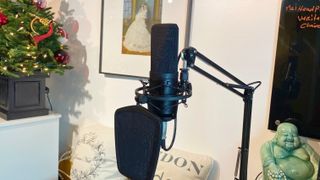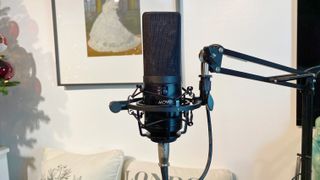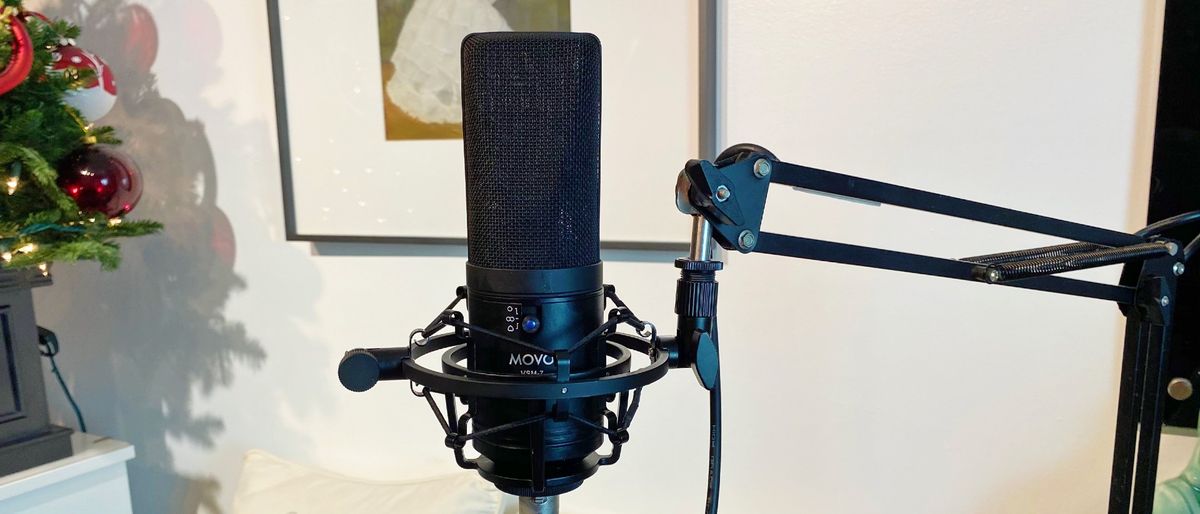Laptop Mag Verdict
The Movo VSM-7 is a solid studio quality, entry-level condenser mic with three polar patterns but sadly misses the mark its competitors have mastered
Pros
- +
Excellent audio reproduction
- +
Solid all-metal mic build
- +
Pop filter
Cons
- -
Doesn’t come with a stand
- -
Could use a USB input
- -
Shock mount quality issues
Why you can trust Laptop Mag
When you pull the Movo VSM-7 XLR mic from its box to feel its all-metal construction and hefty weight, the potential of the mic is palpable. However, as I discovered, great potential and even solid performance can sometimes be a swing and miss. While the mic has excellent audio reproduction, I did discover some minor build issues. The shock mounts adjustment knobs could use some washers and the pop filter is a little brittle, and cracked when I adjusted it. Those two issues aside, the actual mic performance is studio quality, although those issues do affect the Movo VSM-7 overall scores.
Movo VSM-7 pricing and configurations
The Movo VSM-7 XLR microphone costs $124.95 and comes with a ten-foot XLR cable, a shock mount, and a pop filter to prevent plosives.
Movo VSM-7 design
The all-black metal design of Movo VSM-7 feels very solid in the hand. It comes cradled in its black metal shock mount with a plosives filter connected to it; it all feels very sturdy. Just beneath the grill, you have three sets of switches located around the circumference of the microphone. One is a low pass filter switch, the other is for selecting the polar pattern, and the third switch is a 0dB to 10dB Pad (attenuator) that allows you to quickly lower the output for louder talkers or singers. On the side of each switch are white colored indication symbols for your adjustments, and an all-white Movo VSM-7 logo beneath the switches which you barely notice because the shock mount is in the way.
The Movo VSM-7 looks and feels like a professional studio microphone and measures 9.69 x 8.15 x 6.14 inches and weighs 1.8 pounds. It does not come with a stand of any kind but does come with a shock mount with an adjustable pop filter mounted to the shock mount.

The VSM-7 is a little heavier than most USB mics and requires more time and effort to set up so it’s not one I suggest taking with you for on the go interviews unless you have a super portable setup like the Roland Go: LiveCast, which can also supply the needed power (24v or 48v Phantom) to the Movo VSM-7.
Unlike USB mics like the Hyper X Quadcast or the Blue Yeti Nano, the Movo requires an outside power source provided by a pre-amp or mixer to work. Although the Roland Go: LiveCast is an amazing lightweight device, it requires a power source so that it can power XLR mics such as the Movo VSM-7. So before purchasing an XLR microphone, understand that there will be other elements you will have to purchase to get the most out of it or to use it at all.
In the case of the Movo VSM-7, you will need to invest in a stand or boom arm, a mixer or preamp for powering and connecting to a recording device or computer so you can record or live stream. The sound quality of XLR mics is undeniable, however, it tends to be a larger financial investment and, with most of today's USB mics offering equal recording quality, it may be more budget-friendly to avoid an XLR microphone entirely. It truly depends on your requirements and needs.
Movo VSM-7 microphone quality
The Movo VSM-7 is an XLR cardioid condenser microphone with three polar patterns that are selectable via the switch near the center of the unit. You can choose from a cardioid, which is best for a single user, bi-directional worked excellently while I was recording myself and my girlfriend in a test podcast, and the omnidirectional microphone polar pattern worked well while recording myself, my girlfriend, and background audio, simulating a third person.
While recording, we tested the low-pass filter and the pad switch both of which functioned excellently, shaping the audio by increasing or lowering frequency sensitivity and response to ensure there was no distortion. The low-pass filter focused on our voices while keeping background noise to a minimum and, in combination with the 0dB pad switch 0dB and 10dB pad switch, helped to shape the audio to our liking and needs.

Overall, regardless of what pattern I used or which filter was chosen, the Movo VSM-7 captured the timbre in my voice wonderfully with rich reproduction of the natural bass in my voice or the terrible highs I produced while trying to pull off my Phillip Bailey falsetto impression while singing Earth, Wind & Fire’s “Reasons.”
While recording our podcast, the large 34mm Gold-Sputtered Diaphragm captured every minute change in my voice with tremendous accuracy; the warmer tones were chesty and clear as I dropped an octave to try my hand at a Barry White impression. In the end, my girlfriend wishes I never sang “I’m Never Gonna Give You Up.” The audio recorded was colored and excellent, my impression was beyond awful but the Movo VSM-7 did all it could to make it sound its best.
Software
Being that the Movo VSM-7 is not a USB microphone, it doesn’t come with or require software. However, whichever digital mixer or preamp you use will come with a software suite to record, edit and manipulate your audio. I used a Roland GO: LIVECAST to act as a mixer, preamp, and supply power to the Movo. The GO: LIVECAST has an XLR connection and the ability to provide the 48v of Phantom power I needed to fire it up.
Once connected to the LiveCast’s XLR port, I downloaded the Roland GO: LIVECAST software onto my iPhone 11, then connected my phone to the Roland via the supplied Lightning to USB Micro-B type cable and I was off to the races, recording not just audio but video via my iPhone’s camera. I will cover the whole set up and software in my upcoming review of the Roland GO: LIVECAST.
Bottom Line
The Movo VSM-7 is an excellent XLR Condenser microphone that will level up the quality of your podcast, streaming, or music recording. It’s relatively affordable, at just $124.95, but the setup becomes expensive when you consider you need other equipment to use it. If you purchase the Movo VSM-7, you have to be prepared to spend money on a stand and a mixer or other device, such as a preamp. Amazon offers a packaged deal that includes the Movo VSM-7, a microphone arm stand, and the Focusrite Scarlett Solo (3rd Gen) USB Audio Interface preamp that also comes with Pro Tools audio editing software for $269.93.
If your podcast is growing, or if your streaming fanbase is growing, you may want to take a look at such a setup. But if you’re just starting, I highly recommend getting a USB mic like a Blue Yeti Nano, which offers similar recording quality at a lower price and is plug-and-play ready. If you’re a more experienced podcaster, musician, or streamer and you want the option of both an XLR connection and USB, I recommend the Shure MV7, which has both connections, reproduces rich, clear audio while recording, and comes with very user-friendly software.
The Movo VSM-7 is an excellent XLR condenser mic but it’s not for everyone and requires extra gear. I would like to see Movo incorporate a USB port and 3.5 mm audio jack for monitoring from the unit itself.
Mark has spent 20 years headlining comedy shows around the country and made appearances on ABC, MTV, Comedy Central, Howard Stern, Food Network, and Sirius XM Radio. He has written about every topic imaginable, from dating, family, politics, social issues, and tech. He wrote his first tech articles for the now-defunct Dads On Tech 10 years ago, and his passion for combining humor and tech has grown under the tutelage of the Laptop Mag team. His penchant for tearing things down and rebuilding them did not make Mark popular at home, however, when he got his hands on the legendary Commodore 64, his passion for all things tech deepened. These days, when he is not filming, editing footage, tinkering with cameras and laptops, or on stage, he can be found at his desk snacking, writing about everything tech, new jokes, or scripts he dreams of filming.

